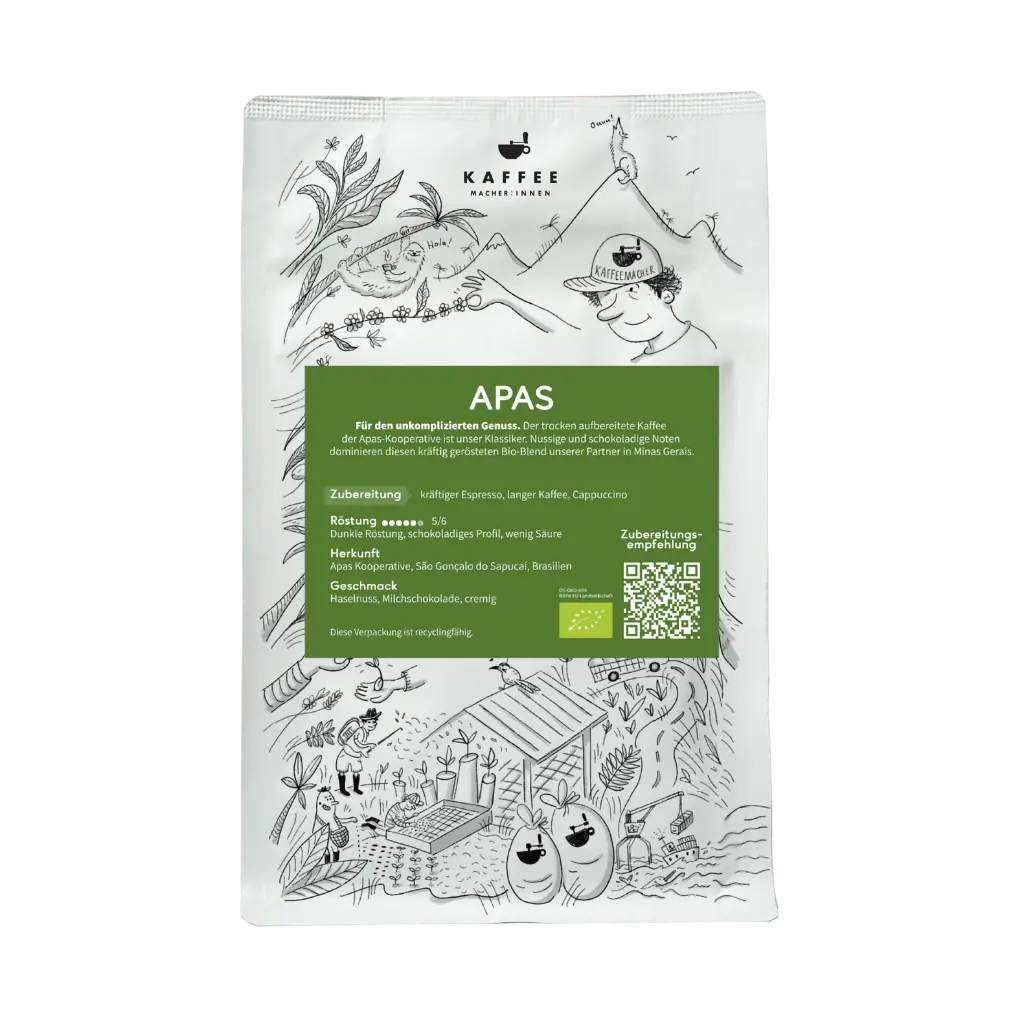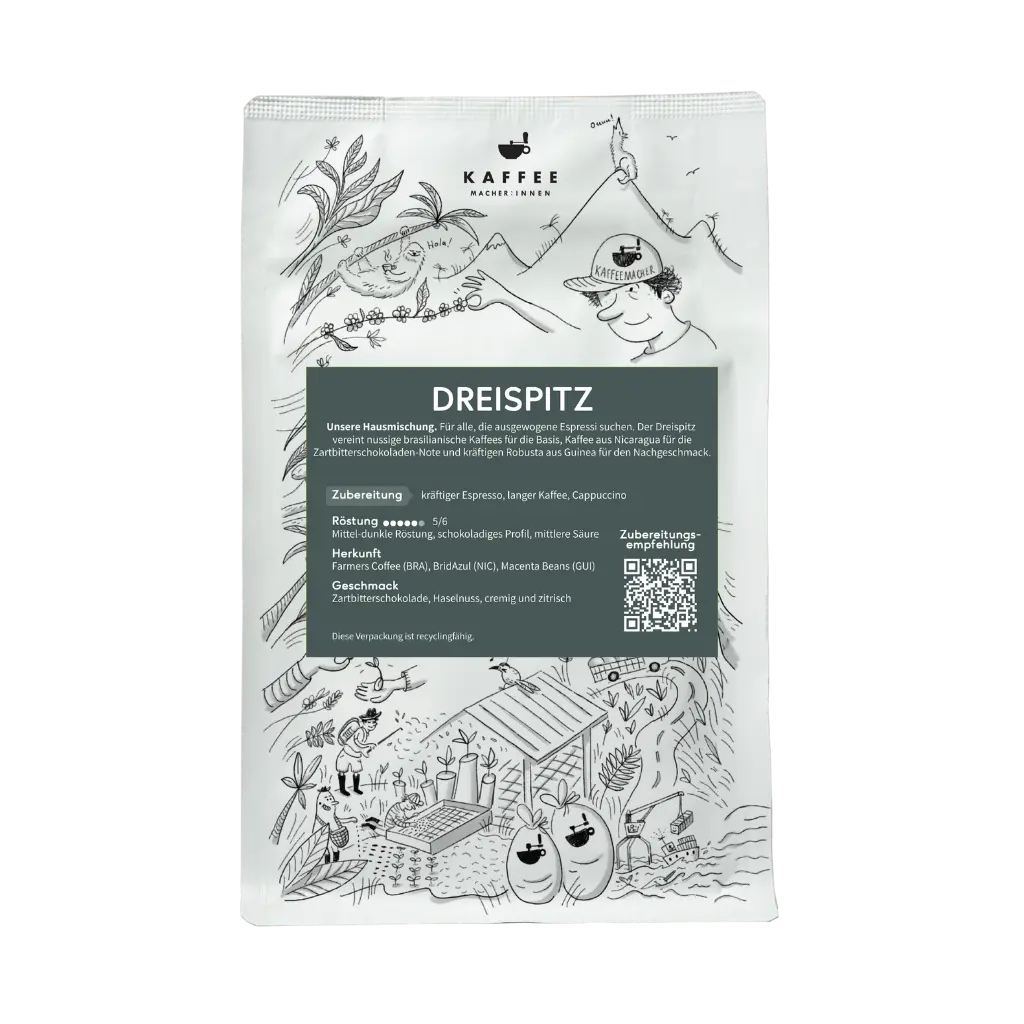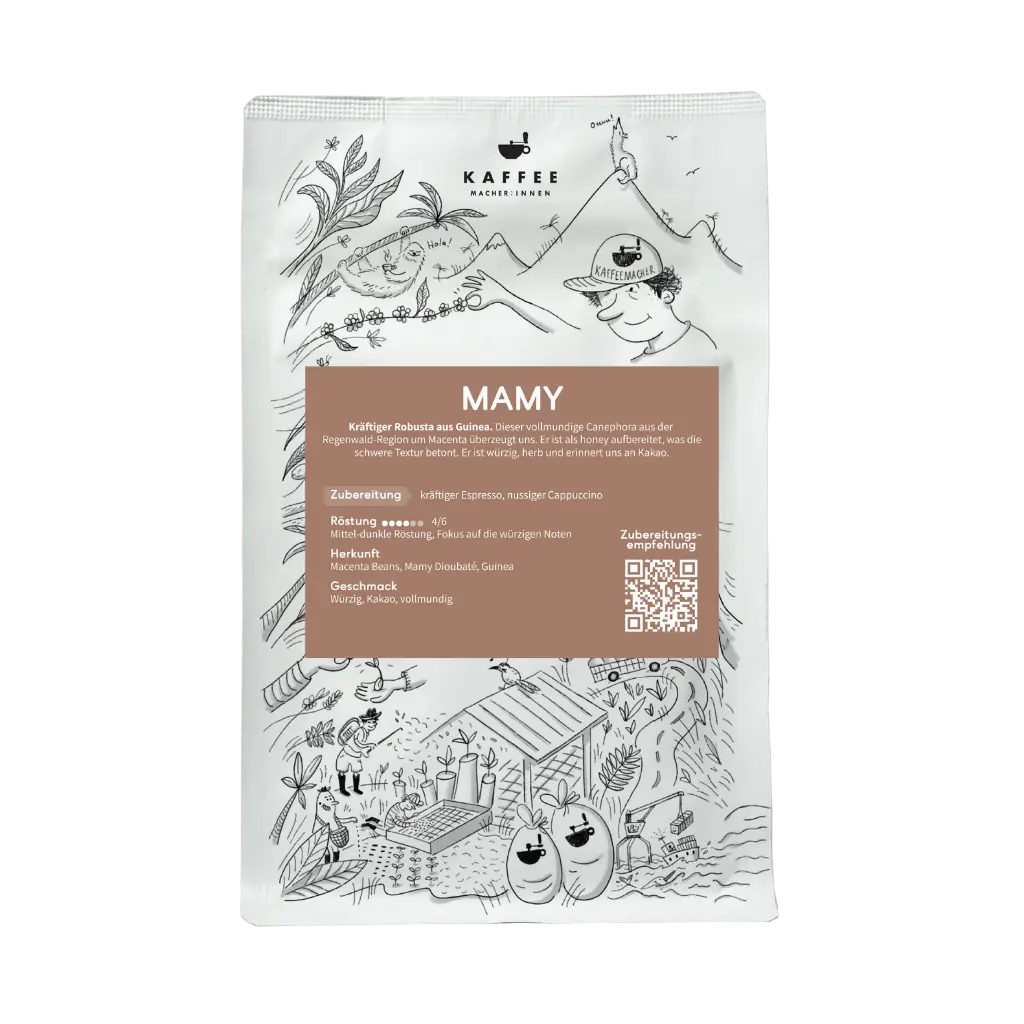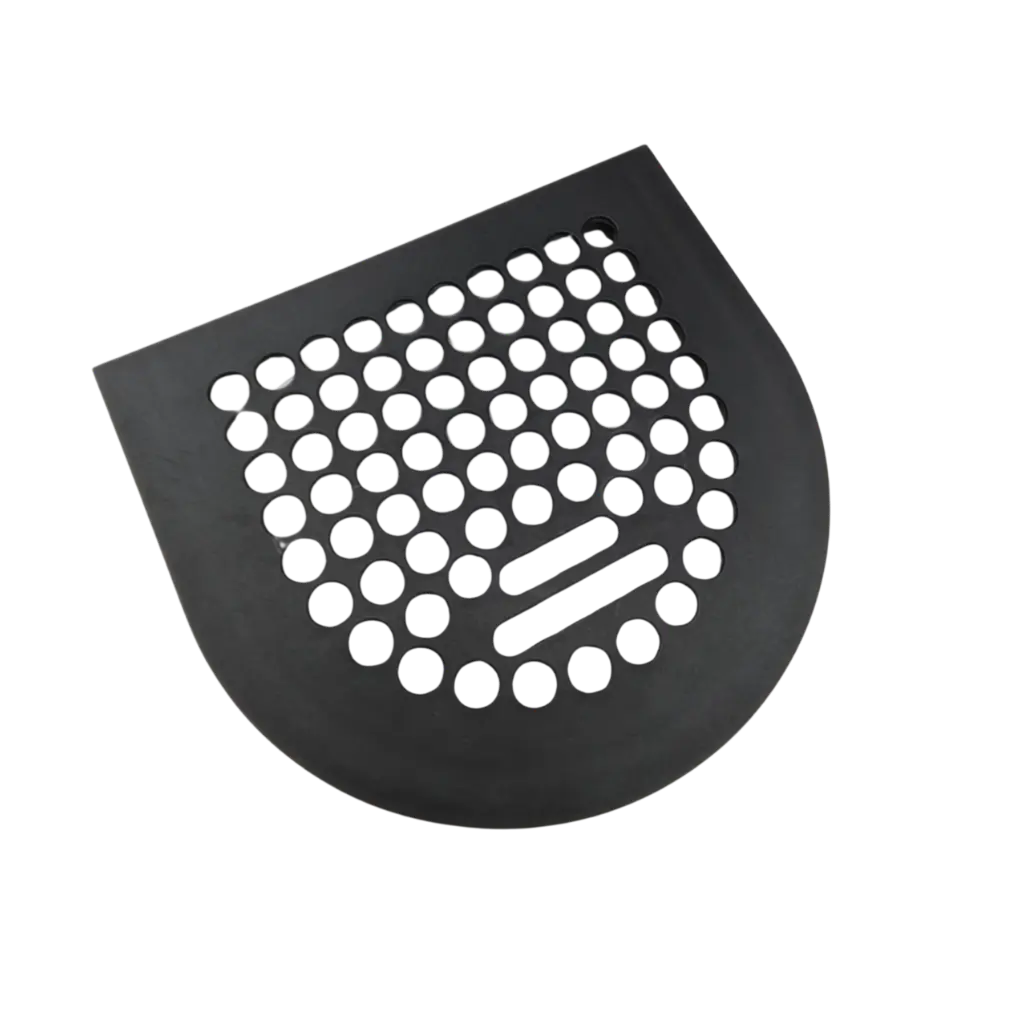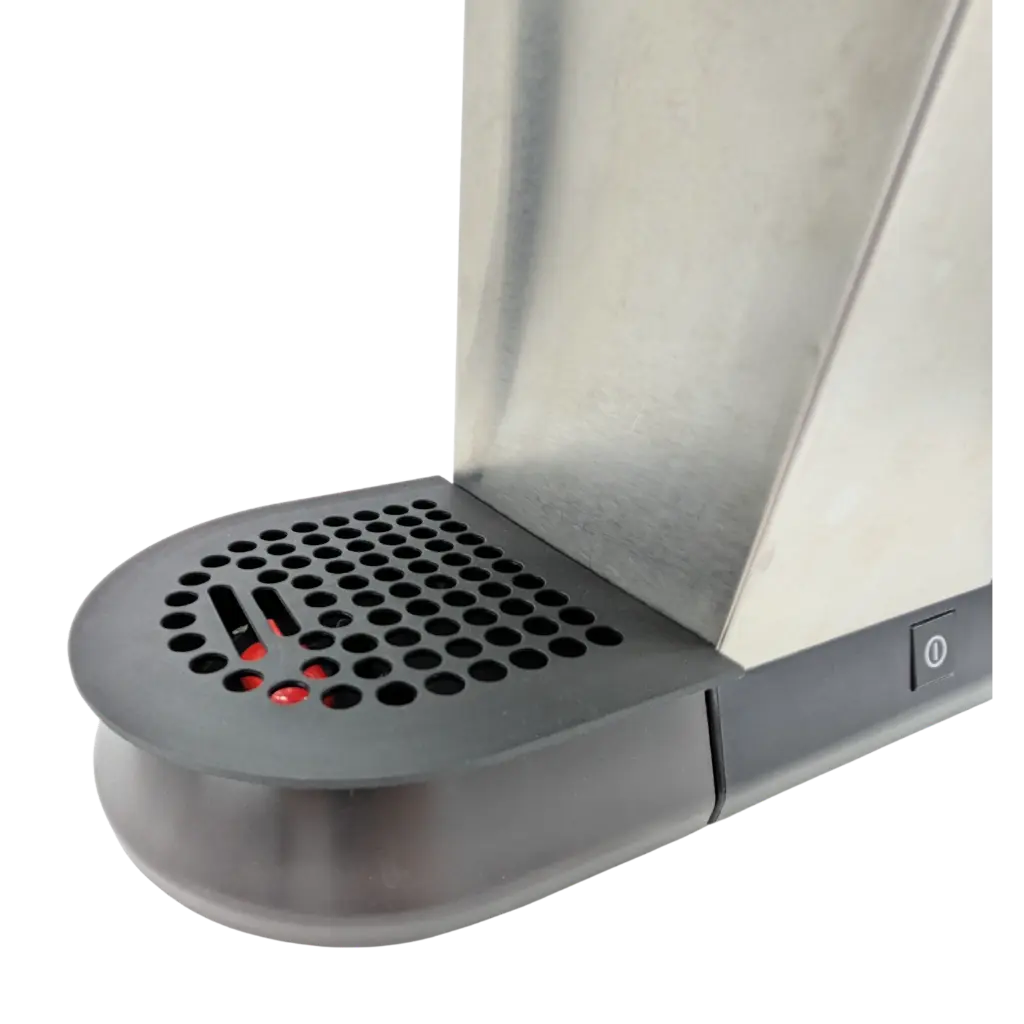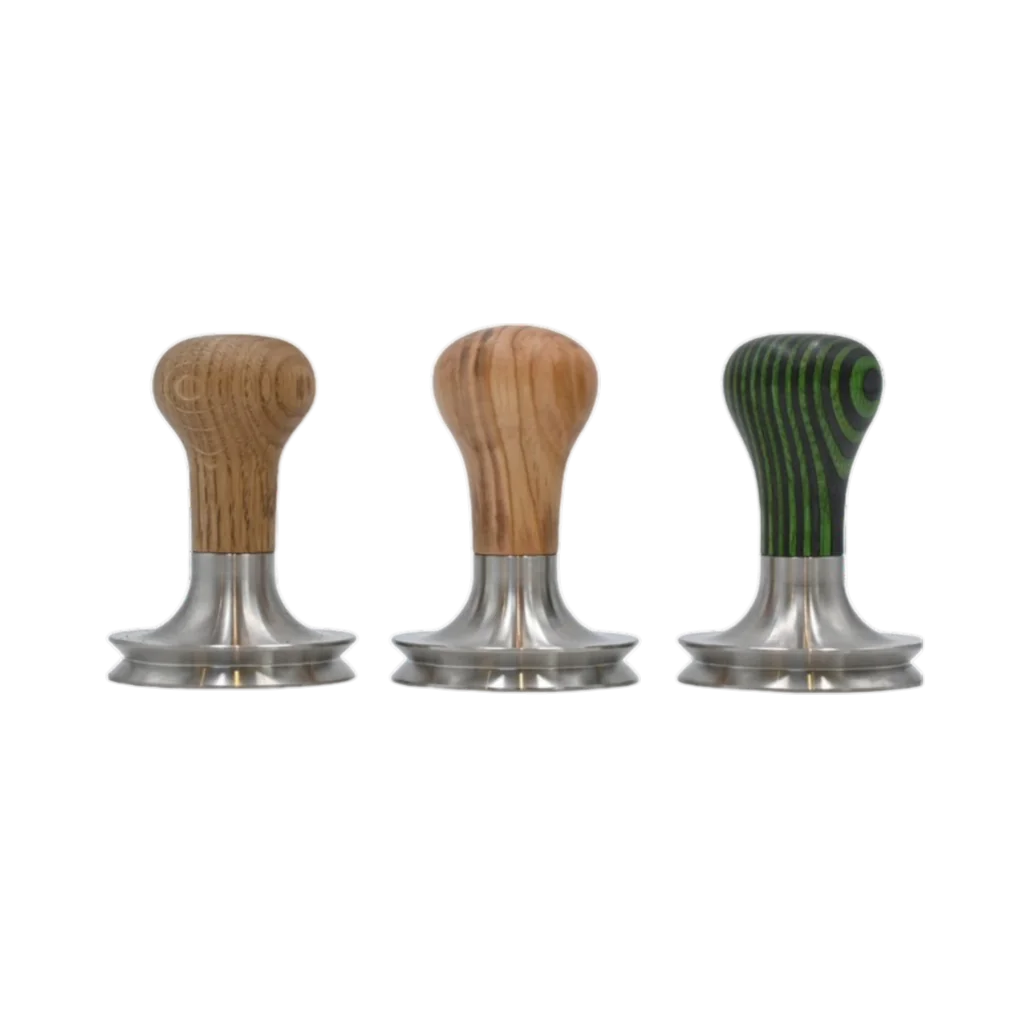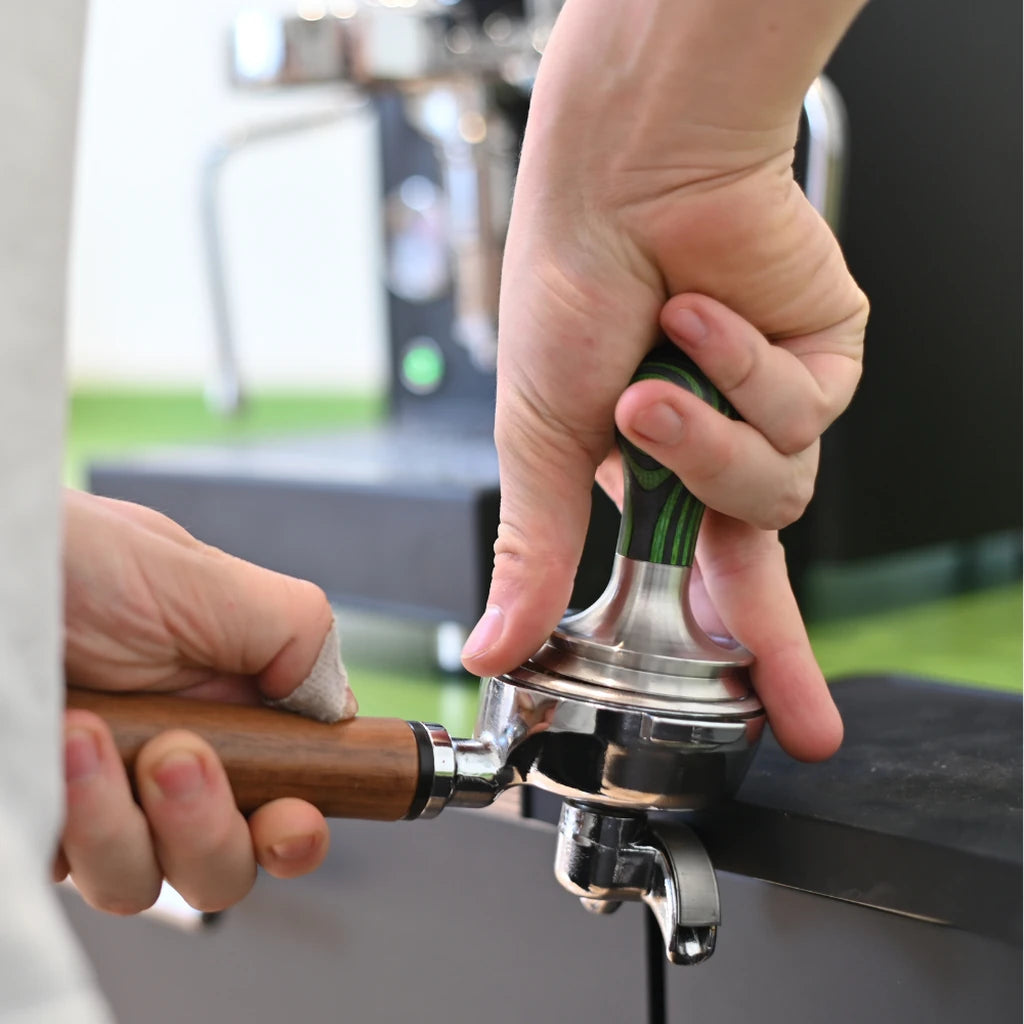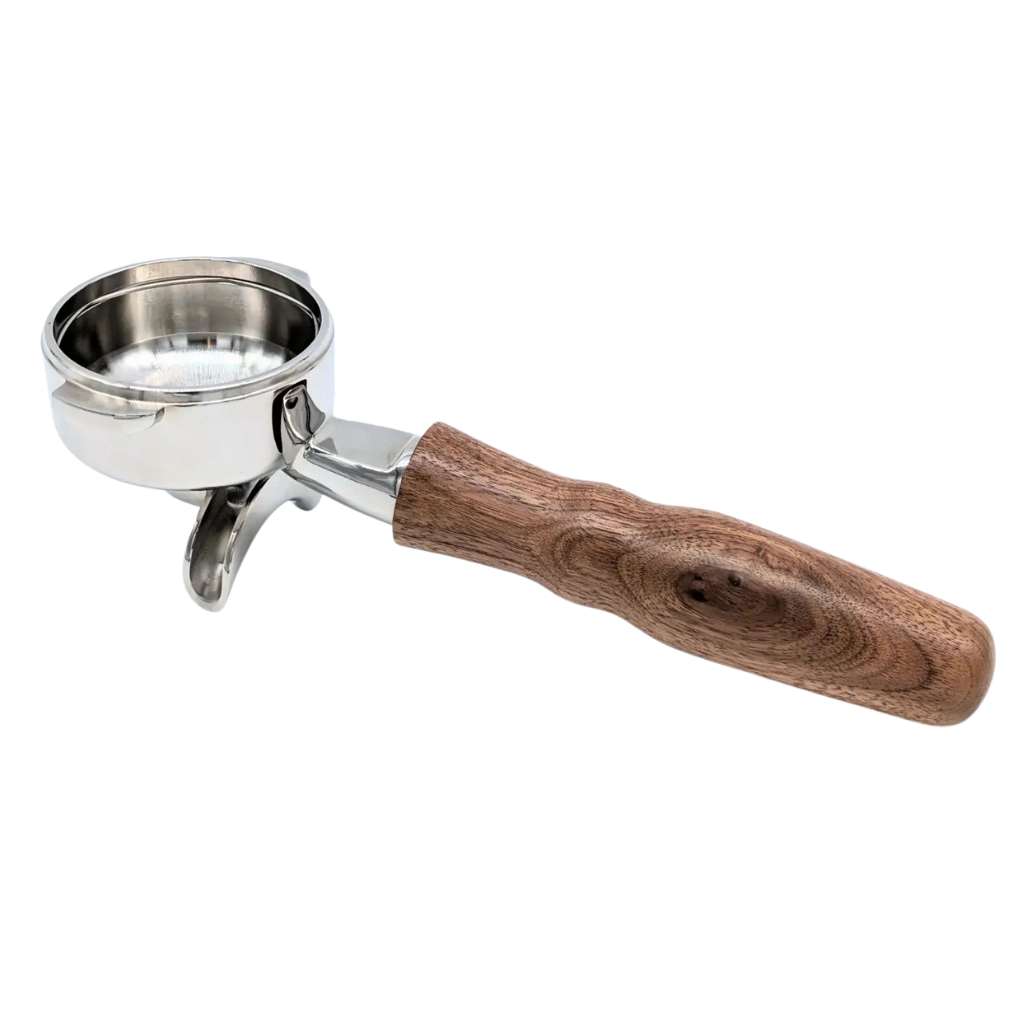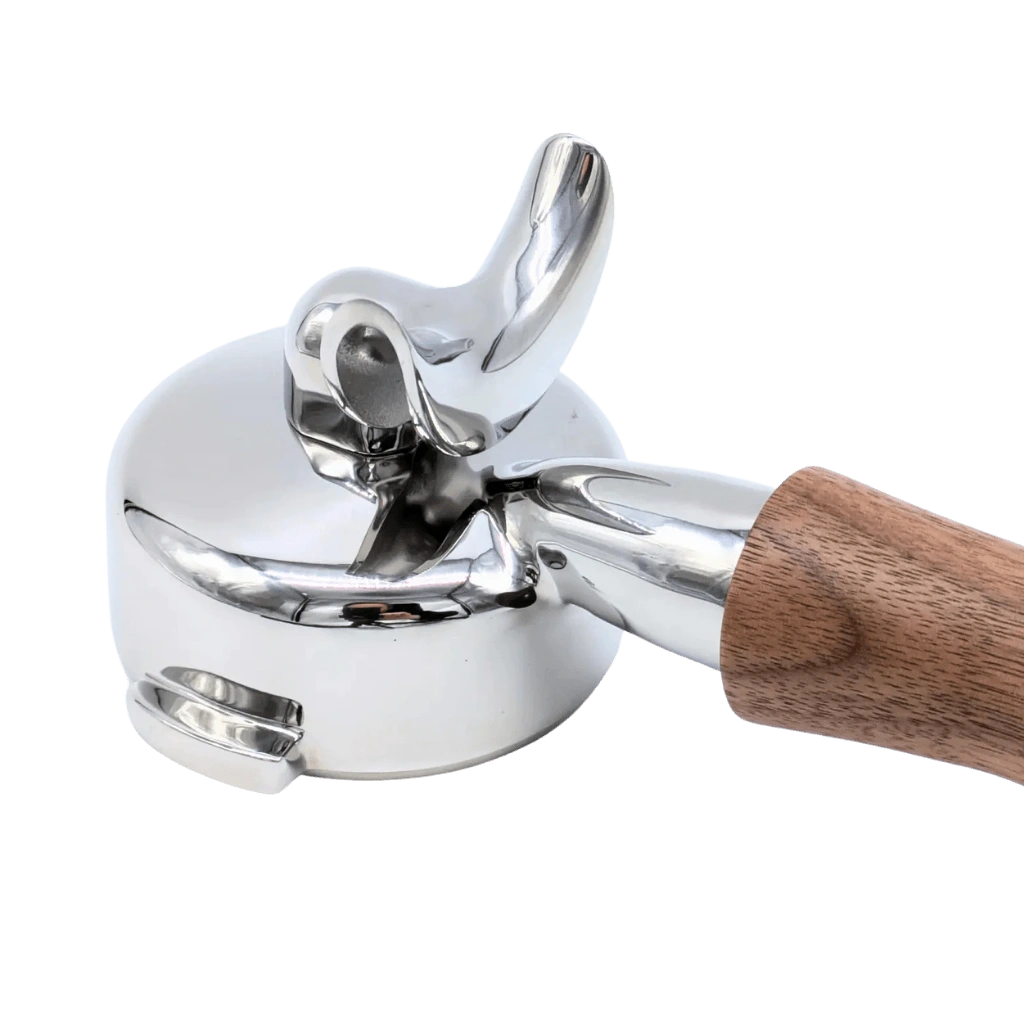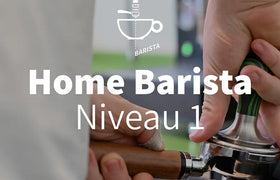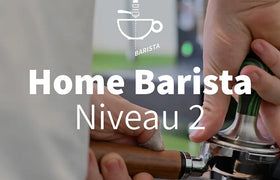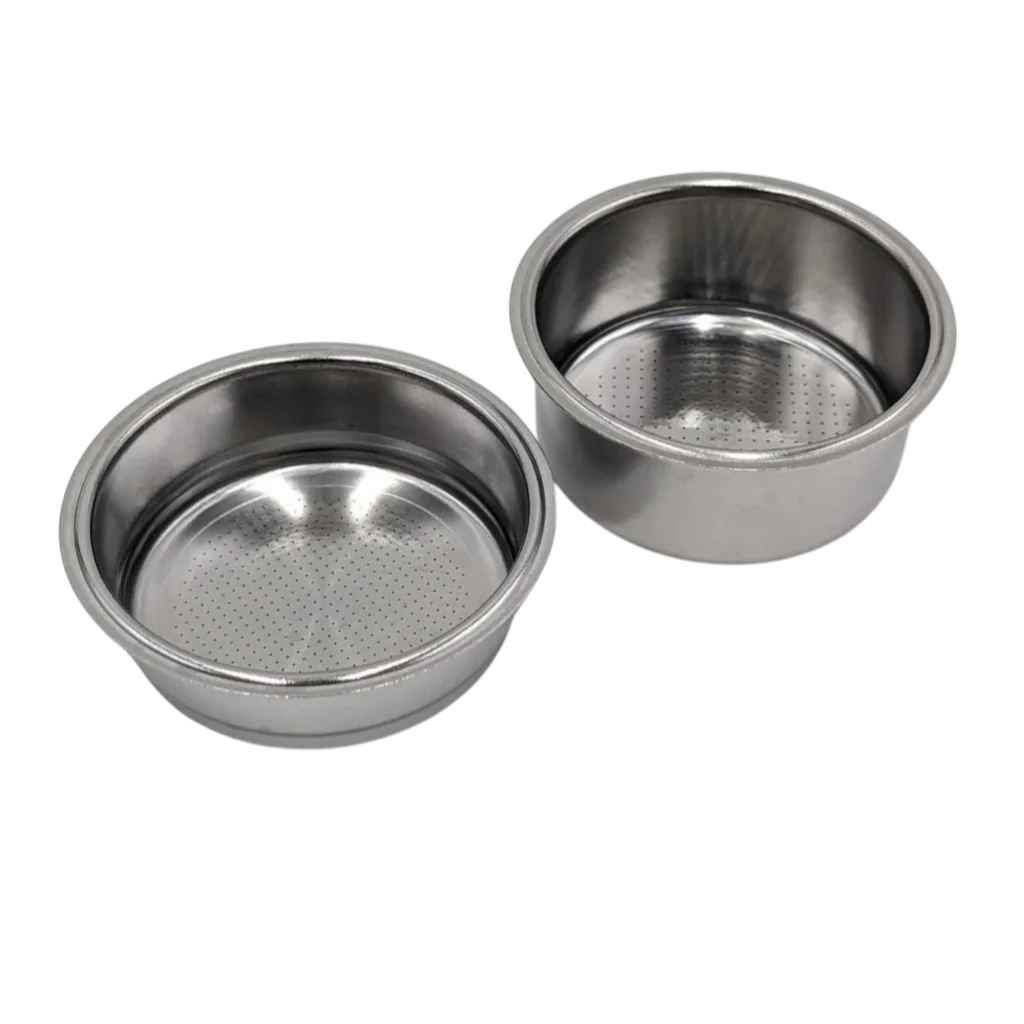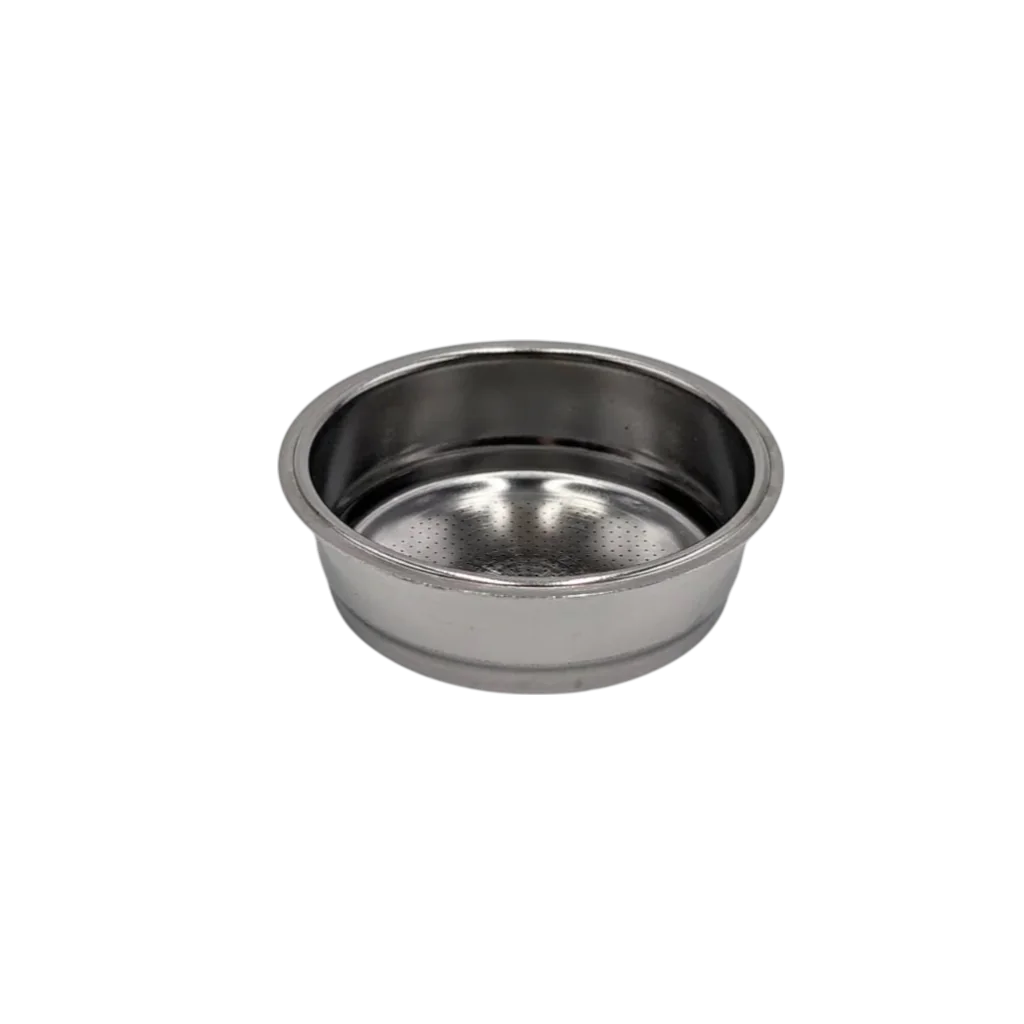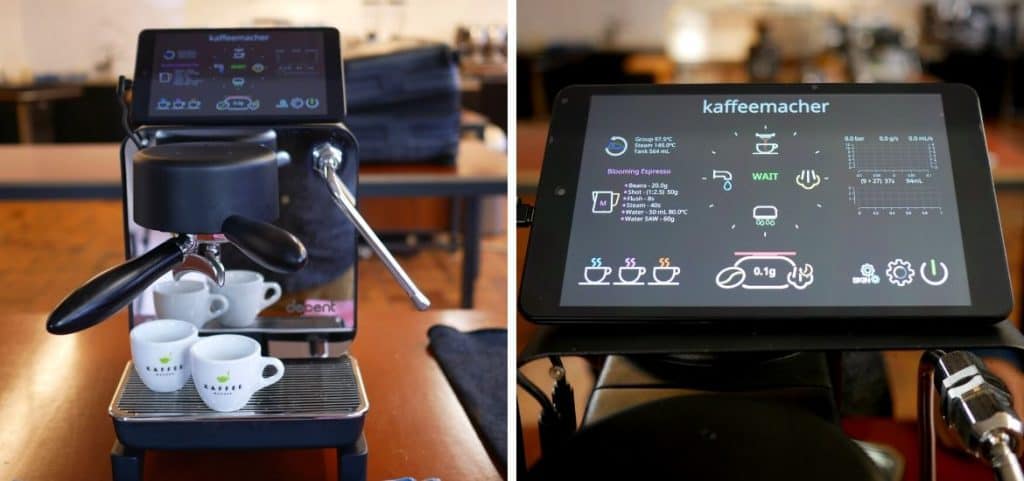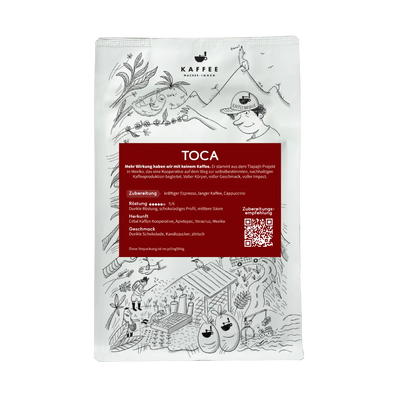If I were to spend €2,500 on an espresso machine again, it would be a Decent espresso machine. What this delivers is a coffee playing field that is second to none. The Decent espresso machine could be as disruptive to the ambitious home market, roasteries, and even restaurant concepts as the Ikawa has disrupted the sample roaster market.
This article was written after a four-hour test of the Decent. Patrizio Frigeri visited us at the Coffee Academy and walked us through the different functions. Patrizio is a two-time Swiss Vice Barista Champion (2012, 2013) and works as an engineer and roaster. He has been making his espresso with the Decent for six months.
Appearance, basic equipment and options
The Decent arrived with its own rolling case, complete with all the necessary tools. Anyone who has ever loaded or reloaded a professional home machine like the La Marzocco GS3 will miss their workout or turn green with envy. The machine can be assembled in just a few steps.
Included: an Android tablet for control, although the software can also be installed on your own hardware.
Two fired ceramic bowls serve as a water reservoir and a drip tray. Some might argue that these are more unstable than a plastic container. But who hasn't wondered how to clean the plastic water reservoir on their Dalla Corte Mini? The ceramic bowls are open and, of course, dishwasher safe.
A handle that screws onto the front of the machine solves one problem: it compensates for the machine's low weight. Lighter espresso machines often rotate when clamped.
Finally, a scale connected via Bluetooth to the tablet and espresso machine. We'll use this later to calibrate the milk jugs and control the machine.
The machine is available in various models. The DE1+ version is designed for private households, while the Decent Espresso DE1Pro is aimed at offices, home baristas, and restaurants. With additional kits, the DE1XL model connects to mains water and external boilers, making it suitable for more demanding gastronomic applications.
The machine measures 22.5 cm wide, 42.5 cm high including the panel, and 48.3 cm deep, including the handles of the holder and portafilter. The machine weighs 13 kg and comes in a matching carrying case.
The housing is made entirely of metal and is well-made. Unlike many high-quality dual-boiler machines priced above €2,000, the portafilters and sieves are extremely precise and microscopically inspected. Professional 58.5mm tampers can be used.

The first espresso – what’s that crackling?
We still have a lot to cover technologically to fully describe the machine. But before we delve into those details, let's make our first espresso.
It rattles, sputters, and spits out noises we've never heard before from an espresso machine. What's that? Every vibration pump is loud. But the noise from the Decent takes some getting used to. It sounds like a specialty espresso if you're used to dark Italian espressos. But today we're not looking to win an acoustic award; we're looking to rate coffee. Incidentally, the reason is that the phase-control system doesn't put the vibration pump under full load, but rather uses it according to the desired pressure curve.

We'll brew a "classic Italian espresso." But we could also follow the profile of a lever machine or deviate completely from the usual path. With the control software, you can create virtually any pressure profile for any espresso machine.
The duration of the pre-infusion can be adjusted or deactivated in just a few steps. We start with an increasing curve to 4 bar and then continue with a pressure of 9 bar.
For espresso, we use our Alessandro filter coffee. It's a really light roast and tastes way too acidic with this profile. With a "normal" espresso machine, we'd typically start adjusting the grind, changing the brewing ratio, or switching coffee. Not so with the Decent.
Changing profiles instead of changing the mill
Of course, we can also work traditionally with the Decent. If we continue with filter coffee, we could, for example, grind coarser and switch from a 1:2.5 (20 grams of coffee in the portafilter, 50 grams of espresso) to a 1:3 (20 grams in and 60 grams out). Adjusting the brewing temperature could also help, if the espresso machine allows it.
With the Decent espresso machine, we're changing the approach. We're switching from a pressure profile to a flow profile.
Pressure profile vs. flow profile in an espresso machine
Most espresso machines operate at a constant pressure throughout the brewing process, e.g., 8 or 9 bar. Some have a type of pre-brew due to their design. Pressure profile machines allow you to control the pressure during brewing. This principle is used in espresso machines for the home market, such as the La Marzocco GS3 MP, and, of course, in commercial machines.
The Decent allows for a different type of control, namely flow control, or flow rate control during output. Instead of controlling the pressure, it adjusts it to the effective output speed. If the water flows through the coffee cake too quickly, either because the grind isn't fine enough or because channeling occurs, the machine reduces the pressure. This results in a less aggressive extraction and increases the likelihood that the espresso will be more enjoyable than it would have been with a "normal" pressure profile.
The machine can, in a way, repair an imperfect grind or improper leveling and tamping. Of course, it can only do this partially, and proper coffee preparation is also essential for producing truly good coffee.

Mixed water and temperature Decent
The Decent controls the water temperature directly above the shower. A built-in temperature sensor constantly communicates with the software and adjusts the mixture of hot and cold water to the desired temperature. This is the only way to achieve the Decent principle: controlling and anticipating the requirements. Other espresso machines install the control shortly after the boiler or the thermal unit and program the temperature using a standard deviation based on the expected heat loss up to the water outlet.
The Decent has two thermoblocks installed, one for the brewing water and one for frothing the milk. These can't be used simultaneously, because the pump used is fully utilized in both cases. The thermoblock principle has advantages and disadvantages. The advantages include the fact that no large kettle needs to be heated, making them more energy-efficient and faster to use (approximately 5 minutes for the first espresso with the Decent). The disadvantage is often the temperature consistency. However, this is less due to the thermoblock, but rather to the fact that these are often installed in cheaper machines, which saves on temperature control units and sensors.
Decent follows a similar approach to Sage and demonstrates what's possible when you don't let a thermoblock heat up on its own, but instead complement it with useful tools. Used in this way, I believe there's a strong case for the thermoblock and related systems (thick film heaters) replacing boiler systems as the supposed pinnacle of home espresso machine technology.

Play with me – set up and save profiles
The machine's settings are virtually limitless. We brewed an espresso with a brewing time of 50 seconds. It was truly delicious. Scott Rao, a virtuoso in extraction matters, writes in his blog about the extended brewing breaks he takes mid-espresso. This is reminiscent of brewing filter coffee, where you also take a degassing or bloom break.
The possibilities with the Decent in terms of flow, pressure, and temperature are so vast that it's easy to get lost. Fortunately, you can use the pre-programmed profiles and also consult the community, which I'll write about below.
The Bluetooth scale also plays a key role in the control system. It communicates with the software and weighs and records the effective amount of espresso in the cup. The scale is robust and part of the machine package. It functions similarly to an Acaia, but looks more like a heavy-duty tool. I accidentally dropped it on the floor, but it didn't cause any lasting damage. The scale enables volumetric control. For example, when there are 40 grams of espresso in the cups, the scale sends the command to the espresso machine to stop.

You can also froth milk
Anyone who has just spent several weeks developing a new brewing profile might be less interested in the Decent Espresso's milk frothing capabilities. But even here, the machine performs well. Thanks to its dedicated heater, frothing can be done immediately after brewing (not simultaneously due to the pump's workload).
The Bluetooth scale is used here again. The jug size for different jugs can be programmed. The amount of milk is then added to the scale. Based on your preferences, a frothing time can be programmed. Optionally, a temperature sensor can be used, which also communicates with the software.
In our case, we simply positioned the carafe once and inserted the milk wand into the milk. The machine then frothed the milk into a silky, latte-art-worthy foam. This foam was slightly too thick for Philipp's liking, even though we didn't make any fine adjustments.
Community and Decent Diaspora
One highlight of Decent is certainly its community, which thrives on a Basecamp platform. Many users, including founder John Buckmann, provide direct feedback and support with problems and challenges. Some users, such as Damian Brakel and Scott Rao, contribute to the sharing of knowledge, profiles, and further development. The software has open programming interfaces, so numerous mods and skins are available, providing customized views and functions for the machine.
Bugs and potential improvements are also collected on the platform. One result is that Decent has now developed further builds and hardware updates itself, such as a grinder stand that measures the weight of ground coffee and feeds it into the software.
Sharing profiles is reminiscent of the Ikawa principle or Artisan . In both cases, roasting profiles can be shared with a community, thus benefiting everyone.
Pros and Cons and Conclusion
As you can see from the article, I was thrilled with the possibilities the Decent offers me. The variety of functions is gigantic, and the playing field is enormous. Options can sometimes be overwhelming. This machine is only suitable for you if you can ignore options.
If you're looking for pure, simple functionality, ideally with just one button, this machine isn't the right choice for you. If you don't appreciate digital formats, you won't be happy with the Decent at the moment either. If you're setting up the machine in a museum or a noise-sensitive environment, the acoustics will likely be problematic.
Anyone who wants to learn something about espresso, challenge themselves, and perhaps discover new things will take a big step with the Decent. For coffee schools, roasters, and coffee aficionados, I can't imagine a better espresso machine in terms of value.
As coffee makers, we'll be bringing one of these machines to our school and incorporating it into our courses. We can also produce a few videos, tests, and guides on espresso extractions for you.
Visit Decent Espresso's website: https://decentespresso.com/
From the failed ZPM Kickstart to Decent Espresso. Article inBarista Magazine.
We have no financial affiliation with Decent. As always, we write, test, and tinker freely, in this case after testing the machines of our friend Patrizio Frigeri, a passionate Decent Espresso user.




